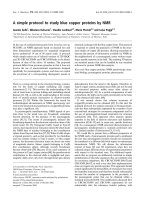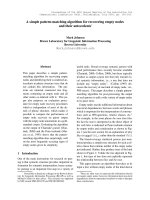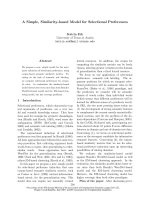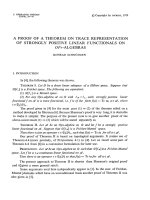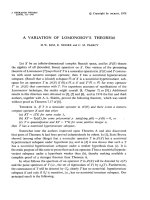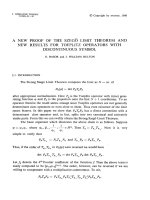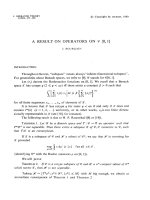Báo cáo toán học: "A simple Havel–Hakimi type algorithm to realize graphical degree sequences of directed graphs" ppsx
Bạn đang xem bản rút gọn của tài liệu. Xem và tải ngay bản đầy đủ của tài liệu tại đây (142.92 KB, 10 trang )
A simple Havel–Hakimi type algorithm to realize
graphical degree sequences of directed graphs
∗
P´eter L. Erd˝os and Istv´an Mikl´os
A. R´enyi Institute of Mathematics, Hungarian Academy of
Sciences, Budapest, PO Box 127, H-1364, Hungary
{elp} {miklosi}@renyi.hu
Zolt´an Toroczkai
Interdisciplinary Center for Network Science and Applications
and Department of Physics University of Notre Dame
Notre Dame, IN, 46556, USA
Submitted: May 29, 2009; Accepted: Apr 21, 2010; Published: Ap r 30, 2010
Mathematics Subject Classification : 05C07, 05C20, 90B10, 90C35
Abstract
One of the simplest ways to decide whether a given finite sequence of positive
integers can arise as the degree sequence of a simple graph is the greedy algorithm
of Havel and Hakimi. This note extends their approach to directed graphs. It also
studies cases of some simple forbidden edge-sets. Finally, it proves a result which
is useful to design an MCMC algorithm to find random realizations of prescribed
directed degree sequences.
Keywords. network modeling; directed graphs; degree sequences; greedy algorithm
1 Introduction
The systematic study of graphs (or more precisely the linear graphs, as it was called in
that time) began sometimes in the late forties, through seminal works by P. Erd˝os, P.
Tur´an, W.T. Tutte, and others. One problem which received considerable attention was
∗
PLE was partly supported by OTKA (Hungarian NSF), under contract Nos. AT048826 and K 68262.
IM was supported by a Bolyai postdoctoral stipend and OTKA (Hungarian NSF) grant F61730. ZT was
supported in part by the NSF BCS-0826958, HDTRA 201473-350 45 and by Hungarian Bioinformatics
MTKD-CT-200 6-042794 Marie Curie Host Fellowships for Transfer of Knowledge.
the electronic journal of combinatorics 17 (2010), #R66 1
the existence of certain subgraphs of a given graph. For example such a subgraph could
be a perfect matching in a (not necessarily bipartite) graph, or a Hamiltonian cycle, etc.
Generally these substructures are called factors. The first couple of important results
of this kind are due to W.T. Tutte who gave necessary and sufficient conditions for the
existence of 1-factors and f-factors.
In the case of complete graphs, the existence problem of such factors is considerably
easier. In particular, the existence problem of (sometimes simple) undirected graphs with
given degree sequences even admits simple greedy algorithms for its solution.
Subsequently, the theory was extended for factor problems of directed graphs as well,
but the greedy type a lgorithm mentioned above, to the best knowledge o f the authors, is
missing even today.
In this paper we fill this gap: after giving a shor t and co mprehensive (but definitely
not exhausting) history of the f-factor problem (Section 2), we describe a greedy algo-
rithm to decide the existence of a directed simple graph possessing the prescribed degree
sequence (Section 3). In Section 4 we prove a consequence of the previous existence the-
orem, which is a necessary ingredient for the construction of edge-swap based Markov
Chain Monte Carlo (MCMC) methods to sample directed graphs with prescribed degree
sequence. Finally in Section 5 we discuss a slightly harder existence problem o f directed
graphs with prescribed degree sequences where some vertex-pairs are excluded from the
constructions. This result can help to efficiently generate all possible directed graphs with
a given degree sequence.
2 A brief history (of f-factors)
For a given function f : V (G) → N ∪ {0}, an f-factor of a given simple graph G(V, E) is
a subgraph H such tha t d
H
(v) = f(v) for all v ∈ V. One of the very first key results of
modern gr aph theory is due to W.T. Tutte: in 1947 he gave a complete char acterization
of simple graphs with an f-factor in case of f ≡ 1 (Tutte’s 1-factor theorem, [14]). Tutte
later solved the problem of the existence of f -factors fo r general f ’s (Tutte’s f-factor
theorem, [15]). In 1954 he also found a beautiful graph transformation to handle f-
factor problems via perfect matchings in bipartite gr aphs [16]. This also gave a clearly
polynomial time algorithm for finding f-fa ctors.
In cases where G is a complete g raph, the f-f actor problem becomes easier: then we
are simply interested in the existence of a graph with a given degree sequence (the exact
definitions will come in Section 3). In 1955 P. Havel developed a simple greedy algorithm
to solve the degree sequence problem for simple undirected graphs ([8]). In 1 960 P. Erd˝os
and T. Gallai studied the f-factor problem for the case of a complete graph G, and proved
a simpler Tutte-type result for the degree sequence problem (see [3]). As they already
pointed out, the result can be derived directly form the original f-factor theorem, taking
into consideration the special properties of the complete graph G, but their proof was
independent of Tutte’s proof and they referred to Havel’s theorem.
In 1962 S.L. Hakimi studied the degree sequence problem in undirected graphs with
multiple edges ([6]). He developed an Erd˝os-Gallai type result for this much simpler case,
the electronic journal of combinatorics 17 (2010), #R66 2
and for the case of simple graphs he rediscovered the greedy algorithm of Havel. Since
then this algorithm is referred to as the Havel–Hakimi alg orithm.
For directed gra phs the analogo us question of recognizability of a bi-graphical-sequence
comes naturally. In this case we are given two n-element vectors d
+
, d
−
of non-negative
integers. The problem is the existence of a directed graph on n vertices, such that the
first vector represents the out-degrees and the second one the in-degrees of the vertices
in this graph. In 195 7 D. Gale and H. J. R yser independently solved this problem for
simple directed graphs (there are no par allel edges, but loops are allowed), see [5, 13].
In 1958 C. Berge generalized these results for p-graphs where at most p parallel edges
are allowed ([1]). (Berge calls the out-degree and in-degree together the demi-degrees.)
Finally in 1973, the revised version of his bo ok Graphs ([2]) gives a solution f or the p-
graph problem, loops excluded. To show some of the afterlife of these results: D. West
in his renowned recent textbook ([17]), discusses the case of simple directed g r aphs with
loops allowed.
The analog of f-factor problems for directed graphs has a sparser history. Øystein
Ore started the systematic study of that question in 1956 (see [11, 12]). His method is
rather a lg ebraic, and the finite and infinite cases - more or less - are discussed together.
The first part develo ped the tools and proved the directly analogous result of Tutte’s
f-factor problem for finite directed graphs (with loops), while the second part dealt with
the infinite case.
In 1962 L .R . Ford and D.R. Fulkerson studied, generalized and solved the “original”
f-factor problem for a directed graph
G ([4]). Here lower and upper bounds were given for
both demi-degrees of the desired subgraph (no parallel edges, no loops) with the original
question naturally corresponding to equal lower and upper bounds. The solutions (as well
as in Berge’s cases) are based o n network flow theory.
Finally, in a later paper Hakimi also proves results fo r bi-graphical sequences, however,
without presenting a directed version of his orig inal greedy algorithm (see [7]).
3 Greedy algorit hm to realize bi-graphical sequence s
A sequence d = {d
1
, d
2
, . . . , d
n
} of nonnegative integers is called a graphical s equence if a
simple graph G(V, E) exists on n nodes, V = {v
1
, v
2
, . . . , v
n
}, whose degree sequence is d.
In t his case we say that G realizes the sequence d. For simplicity of the notation we will
consider only sequences of strictly positive integers (d
n
> 0) to avoid iso la t ed points. The
following, well-known result, was proved independently by V. Havel and S.L. Hakimi.
Theorem 1 (Havel [8], Hakimi [6]) There exists a simple graph with degree sequence
d
1
> 0, d
2
· · · d
n
> 0 (n 3) if and only if there exists one with degree sequence
d
2
− 1, . . . , d
d
1
+1
− 1, d
d
1
+2
, . . . , d
n
. (Note that there is no prescribed ordering relation
between d
1
and the other degrees.)
This can be proved using a recursive procedure, which transforms any realization of the
degree sequence into the form described in the Theorem 1, by a sequence of two-edge
swaps.
the electronic journal of combinatorics 17 (2010), #R66 3
A bi-degree-sequence (or BD S for short) (d
+
, d
−
) = ({d
+
1
, d
+
2
, . . . , d
+
n
}, {d
−
1
, d
−
2
, . . . , d
−
n
})
of nonnegative integers is called a bi-graphical sequence if there exists a simple (no parallel
edges, no loops) directed graph
G(V,
E) on n nodes, V = {v
1
, v
2
, . . . , v
n
}, such that the
out-degree and in- degree sequences tog ether for m (d
+
, d
−
). (That is the out-degree of
vertex v
j
is d
+
j
and its in-degree is d
−
j
.) In this case we say that
G realizes our BDS. For
simplicity, we will consider only sequences of strictly positive integer BD S’s, that is each
degree is 0 and d
+
j
+ d
−
j
> 0, to avoid isolated points.
Our goal is to prove a Havel–Hakimi type algorithm to realize bi-graphical sequences.
To that end we introduce the notion of normal order: we say that the BDS is in normal
order if the entries sa t isfy the following properties: for each i = 1, . . . , n−2 we either have
d
−
i
> d
−
i+1
or d
−
i
= d
−
i+1
and d
+
i
d
+
i+1
. Clearly, all BDS-s can be arranged into normal
order. Note that we made no ordering a ssumption about node v
n
(the pair d
+
n
, d
−
n
).
Theorem 2 Assume that the BDS (d
+
, d
−
) (with d
+
j
+ d
−
j
> 0, j ∈ [1, n]) is in normal
order and d
+
n
> 0 (that is the out-degree of the last vertex is positive). Then (d
+
, d
−
) is
bi-graphical if and only if the BDS
∆
+
k
=
d
+
k
if k = n
0 if k = n ,
(1)
∆
−
k
=
d
−
k
− 1 if k d
+
n
d
−
k
if k > d
+
n
,
(2)
with zero e lements removed (those j for which ∆
+
j
= ∆
−
j
= 0) is bi-graphi cal.
Before starting the proof , we emphasize the similarity between this result and the original
HH-algorithm. As in the undirected case, using Theorem 2, we can find in a greedy way
a proper realization of g r aphical bi-degree sequences.
Indeed: choose any vertex v
n
with non-zero out-degree from the sequence, arrange
the rest in normal order, then make d
−
n
connections fro m v
n
to nodes with larg est in-
degrees, thus constructing the out-neighborhood o f v
n
in the (final) realization. Next,
remove the vertices (if any) from the remaining sequence that have lost both their in- and
out- degrees in the process, pick a node with non-zero out-degree, then arrange the rest
in normal order. Applying Theorem 2 again, we find the final out-neighborhood of our
second chosen vertex. Step by step we find this way the out-neighborhoo d of all vertices,
while their in-neighborhoods get defined eventually (being exhausted by incoming edg es).
Note, that every vertex in this process is picked at most once, namely, when its out-
neighborhoo d is determined by the Theorem, and never again after that.
Our forthcoming proof is not the simplest, however, we use a more general setup to shorten
the proofs of la t er results.
First, we define the partial order among k-element vectors of increasing positive
integers: we say a b iff for each j = 1, . . . , k we have a
j
b
j
.
A possible o ut-neig hborhood (o r PON for short) of vertex v
n
is a d
+
n
-element subset
of V \ {v
n
} which is a candidate for an out-neighborhoo d of v
n
in some graphical rep-
resentation. (In essence, a PON can be any d
+
n
-element subset of V \ {v
n
} but la t er on
the electronic journal of combinatorics 17 (2010), #R66 4
we may consider some restrictio ns on it.) Let A be a PON of v
n
. Then denote by i(A)
the vector of the increasingly ordered subscripts of the elements of A. (For example, if
A = {v
2
, v
4
, v
9
}, then i(A) = (2, 4, 9).) Let A and B be two PONs of v
n
. We write:
B A ⇔ i
B
i
A
. (3)
In t his case we also say that B is to the left of A. (For example, B = {v
1
, v
2
, v
6
, v
7
} is t o
the left of A = {v
2
, v
4
, v
6
, v
9
}.)
Definition 3 Consider a bi-graphi cal BDS sequence (d
+
, d
−
) and let A be a PON of v
n
.
The A-reduced BDS
d
+
A
, d
−
A
is defined as:
d
+
k
A
=
d
+
k
if k = n
0 if k = n ,
(4)
d
−
k
A
=
d
−
k
− 1 if k ∈ i(A)
d
−
k
if k ∈ i(A).
(5)
In other words, if A is a PON in a BDS, then the reduced degree sequence
d
+
A
, d
−
A
is obtained by removing the out-edges o f node v
n
(according to t he set A). As usual, if
for a particular subscript k in the A-reduced BDS we have d
+
k
A
= d
−
k
A
= 0 then the
vertex with this index is to be removed fro m the bi-degree sequence.
Lemma 4 Let (d
+
, d
−
) be a BDS, and le t A be a possible out-neighborhood of v
n
. Fur-
thermore let B be another PON with B = A \ {v
k
} ∪ {v
i
} where d
−
i
d
−
k
and in case
of d
−
i
= d
−
k
we have d
+
i
d
+
k
. Then if (D
+
, D
−
) :=
d
+
A
, d
−
A
is bi-graphical, so is
d
+
B
, d
−
B
.
Proof. Since our A- r educed BDS (D
+
, D
−
) is bi-gr aphical, there exists a directed graph
G which realizes the bi-degree sequence (D
+
, D
−
). We are going to show that in this case
there exists a directed graph
G
′
which realizes the BDS
d
+
B
, d
−
B
. In the following,
v
a
v
b
will always mean a directed edge from node v
a
to node v
b
. Let us now construct
the directed graph
G
1
by adding v
n
v directed edges for each v ∈ A. (Since, according
to (4), in (D
+
, D
−
) the out-degree of v
n
is equal to zero, no pa r allel edges ar e created.)
The bi-degree-sequence of
G
1
is (d
+
, d
−
). Our goal is to construct another realization
G
′
1
of (d
+
, d
−
) such that the deletion of the out-edges of v
n
in the latter produces the BDS
d
+
B
, d
−
B
.
By definition we have v
n
v
k
∈
E
1
, (the edge set of
G
1
) but v
n
v
i
∈
E
1
. At first assume
that there exists a vertex v
ℓ
(ℓ = i, k, n), such that v
ℓ
v
i
∈
E
1
but v
ℓ
v
k
∈
E
1
. (When
d
−
i
> d
−
k
then this happens automatically, however if d
−
i
= d
−
k
and v
k
v
i
∈
E
1
then
it is possible that the in-neighborhood of v
i
and v
k
are the same - except of course
v
k
, v
i
themselves and v
n
.) This means that now we can swap the edges v
n
v
k
and v
ℓ
v
i
into v
n
v
i
and v
ℓ
v
k
. (Formally we create the new graph
G
′
1
= (V,
E
′
1
) such that
E
′
1
=
E
1
\ {v
n
v
k
, v
ℓ
v
i
} ∪ {v
n
v
i
, v
ℓ
v
k
}.) This achieves our wanted realization.
the electronic journal of combinatorics 17 (2010), #R66 5
Our second case is when d
−
i
= d
−
k
, v
k
v
i
∈
E
1
, and furthermore
for each ℓ = i, k, n we have v
ℓ
v
i
∈
E
1
⇔ v
ℓ
v
k
∈
E
1
. (6)
It is important to observe that in this case v
i
v
k
∈
E
1
: otherwise some v
ℓ
would not satisfy
(6) (in order to keep d
−
i
= d
−
k
).
Now, if there exists a subscript m (different from k, i, n) such that v
i
v
m
∈
E
1
but
v
k
v
m
∈
E
1
, then we create the required new graph
G
′
1
by applying the following triple swap
(or three-edge swa p): we exchange the directed edges v
n
v
k
, v
k
v
i
and v
i
v
m
into v
n
v
i
, v
i
v
k
and v
k
v
m
.
By our assumption we have d
+
i
d
+
k
. On one hand side if d
+
i
> d
+
k
holds then due
to the properties v
k
v
i
∈
E and v
i
v
k
∈
E, there exist at least two subscripts m
1
, m
2
= i, k
such that v
i
v
m
j
∈
E but v
k
v
m
j
∈
E a nd at least one of them differs fro m n. Thus, when
d
+
i
> d
+
k
, we do find such an m for which the triple swap above can be performed.
The final case is when d
−
i
= d
−
k
and d
+
i
= d
+
k
. If vertex v
m
does not exist, then we
must have v
i
v
n
∈
E
1
(to keep d
+
i
= d
+
k
), and in this case clearly, v
k
v
n
/∈
E
1
. Therefore, in
this (final) case the graphical realization
G
1
has the properties v
n
v
k
, v
k
v
i
, v
i
v
n
∈
E
1
and
v
n
v
i
, v
i
v
k
, v
k
v
n
∈
E
1
. Then the triple swap
E
′
1
:=
E
1
\ {v
n
v
k
, v
k
v
i
, v
i
v
n
} ∪ {v
n
v
i
, v
i
v
k
, v
k
v
n
} (7)
will produce the required new graphical realization
G
′
1
.
Observation 5 For later reference it is important to recognize that in all cases above, the
transformations from one realization to the next one happened with the use of two-edge or
three-edg e swaps.
Lemma 6 Let (d
+
, d
−
) be a BDS a nd let A and C be two possible out-neighborhoods
of v
n
. Furth ermore assume that C A, that is C is to the left of A. Finally assume
that vertices in A ∪ C are in normal order. Then if
d
+
A
, d
−
A
is bi-graphical, so is
d
+
C
, d
−
C
.
Proof. Since C is to the left of A therefore, there is a (unique) bijection φ : C \ A →
A \ C such that ∀c ∈ C \ A : i({c}) < i({φ(c)} ) (the subscript of vertex c is smaller
than the subscript of vertex φ(c)). (For example, if A = {v
4
, v
5
, v
6
, v
7
, v
8
, v
9
} and C =
{v
1
, v
2
, v
3
, v
5
, v
7
, v
8
}, then C \ A = {v
1
, v
2
, v
3
}, A \ C = {v
4
, v
6
, v
9
}, and φ is the map
{v
1
↔ v
4
, v
2
↔ v
6
, v
3
↔ v
9
}).
To prove Lemma 6 we apply Lemma 4 recursively for each c ∈ C \ A (in arbitrary
order) to exchange φ ( c) ∈ A with c ∈ C, preserving the graphical character at every step.
After the last step we find that the sequence reduced by C is graphical.
Proof of Theorem 2: We can easily achieve now the required graphical realization of
(d
+
, d
−
) if we use Lemma 6 with the current A, and C = {v
1
, . . . , v
d
+
n
}. We can do tha t
since (d
+
, d
−
) is in normal order, therefore the assumptions o f Lemma 6 always hold.
the electronic journal of combinatorics 17 (2010), #R66 6
4 A simple prerequisite for MCMC algorithms to
sample directed gr aph s with given B DS
In practice it is often useful to choose uniformly a random element from a set of objects.
A frequently used tool for that task is a well-chosen Markov-Chain Monte-Carlo method
(MCMC for short). To that end, a g raph is established on the objects and random walks
are generated on it. The edges represent operations which can transfer one object to the
other. If the Markov chain can step from an object x to object y with non-zero probability,
then it must be able to jump to x from y with non-zero probability (reversibility). If the
graph is connected, then applying the well-known Metropolis-Hastings algo rithm, it will
yield a random walk converging to the uniform distribution starting from an arbitrary
(even fixed) object.
To be able to apply this technique we have to define our graph (the Markov chain)
G(d
+
, d
−
) = (V, E). The vertices are the different possible realizations of the bi-graphical
sequence (d
+
, d
−
). An edge represents an o peration consisting of a two or three-edge swap
which transforms the first realization into the second one. (For simplicity, sometimes we
just say swap for any of them.) We will show:
Theorem 7 Let
G
1
,
G
2
be two realizations of the same bi-graphical sequence (d
+
, d
−
).
Then there exists a sequence of swaps which transforms
G
1
into
G
2
through different
realizations of the same bi-graphical sequence.
Remark: In the case of undirected graphs the (original) analogous observation (need-
ing only two-edges swaps) was proved by H.J. Ryser ([13]).
Proof. We prove the following stronger statement:
() there exists a sequence of a t most 2e swa ps which transform
G
1
into
G
2
, where e is
the total number of out-edges in (d
+
, d
−
)
by induction on e. Assume that () ho lds for e
′
< e. We can assume that our bi-graphical
sequence is in normal order on the first n − 1 vertices and d
+
n
> 0. By Theorem 2 there is
a sequence T
1
(T
2
) of d = d
+
n
many swaps which transforms
G
1
(
G
2
) into a
G
′
1
(
G
′
2
) such
that Γ
+
G
′
1
(v
n
) = {v
1
, . . . , v
d
} (Γ
+
G
′
2
(v
n
) = {v
1
, . . . , v
d
}).
We consider now the directed graphs
G
′′
1
(
G
′′
2
) derived from directed graph
G
′
1
(directed
graph
G
′
2
) by deleting all out-neighbors of v
n
. Then bot h directed graphs realize the bi-
graphical sequence (∆
+
, ∆
−
) which, in t urn, satisfies relations (1) and (2). Therefore
the total number of out-degrees is e − d in both directed graphs, and by the inductive
assumption t here is a sequence T of 2(e − d) many swaps which transforms
G
′′
1
into
G
′′
2
.
Now observe that if a swap transforms
H into
H
′
, then the “inverse swap” (choosing the
same edges a nd non-edges and swap them) transforms
H
′
into
H. So the swap sequence T
2
has an inverse T
′
2
which transforms
G
′
2
into
G
2
. Hence the sequence T
1
T T
′
2
is the required
swap sequence: it transforms
G
1
into
G
2
and its length is at most d + 2(e − d) + d = 2e.
the electronic journal of combinatorics 17 (2010), #R66 7
5 Is a BDS bi-g raphical w hen one of its vertex’s out-
neighborhood is constrained?
In network modeling of complex systems (for a rather general reference see [10]) one
usually defines a (di)graph with components of the system being represented by the nodes,
and the interactions (usually directed) amongst the components being represented as the
edges of this directed graph. Typical cases include biological networks, such as metabolic
networks, signal transduction networks, gene transcription networks, etc. The graph is
usually inferred from empirical observations of the system and it is uniquely determined if
one can specify all the connections in the gra ph. Frequently, however, the data available
from the system is incomplete, and one cannot uniquely determine this gr aph. In this
case there will be a set D of (di)graphs satisfying the existing data, and one can be faced
with:
(i) finding a typical element of the class D,
(ii) or generating all elements of the class D.
(A more complete analysis of this phenomenon can be found in [9].) In Section 4 we
already touched upon problem (i) when D is the class of all directed graphs of a given
BDS. The analogous Problem (ii) for undirected graphs was recently addressed in [9]
which provides an economical way of constructing all elements from D. In this Section we
give a prescription based on the method fro m [9], to solve (ii) for the case of all directed
graphs with prescribed BDS. This is particularly useful from the point of view of studying
the abundance of motifs in real-world networks: one needs to know first all the (small)
subgraphs, or motifs, before we study their statistics from the data.
Before we give the details, it is perhaps worthy making the following remark: Clearly,
one way to solve pro blem (i) wo uld be to first solve problem (ii), then choose uniformly
from D. However, in (those very small) cases when reasonable answers can be expected
for problem (ii), problem ( i) is rather uninteresting. In general, however, (i) cannot be
solved efficiently by the use of (ii).
We start the discussion of problem (ii) by pointing out that our new, directed Havel–
Hakimi type algorithm is unable to generate all realization of a prescribed DBS (see
Figure 1).
(0,3)
(2,1)
(2,1)
(2,1)
(2,1)
(2,1)
(2,1)
(0,3)
Figure 1: This graph cannot be obtained by the directed Havel–Hakimi procedure. The
integers indicate node degrees.
The situat io n is very similar to the non-directed case, see [9]. The directed HH-algorithm
must start with a vertex with degree-pair (2, 1), therefore the two vertices of degree-pair
the electronic journal of combinatorics 17 (2010), #R66 8
(0, 3) must be out-neighbors of the same vertex - not as it is shown in the graph in the
Figure.
One possible way to overcome this shortfall is to discover systematically all possible out-
connections from a given vertex v in all realizations of the prescribed graphical BDS.
We do not know a gr eedy algorithm to achieve this. The next best thing we can do
is to develop a greedy algorithm to decide whether a given (sub)set of prescribed out-
neighbors of v would prevent to find a realization of the BDS containing those prescribed
out-neighbors. In the following, we describe such a greedy algorithm. ( It is perhaps
interesting to note tha t this latter problem can be considered as a very special directed
f-factor problem.)
To start, we consider a (d
+
, d
−
) bi-degree sequence together with a forbidden vertex
set F whose elements ar e not allowed to be out-neighbors of vertex v
n
. (Or, just oppositely,
we can imagine that we already have decided that those vertices will become out-neighbors
of v
n
and the BDS is already updated accordingly. The forbidden vertex set governs o nly
the out-neig hbors, since in the process the in-neighbors are born “automatically”.) It is
clear that |F| + 1 + d
−
n
n must hold for the existence of a g r aphical realization of this
F -restricted BDS.
Assume that the vertices are enumerated in such a way that subset F consists of
vertices v
n−|F |
, . . . , v
n−1
and vertices V
′
= {v
1
, . . . , v
n−|F |−1
} are in normal order. (We can
also say that we apply a permuta t io n on the subscripts accordingly.) Then we say that
the BDS is in F -normal order.
Definition 8 Consider a bi-graphical BDS sequence (d
+
, d
−
) in F -normal order, and let
A be a PO N. The A-reduced BDS
d
+
A
, d
−
A
is defined as in (4) and (5), while keeping
in min d the existence of an F set to th e right of A.
In other words, if A is a PON in an F -r estricted BDS, then the reduced degree sequence
d
+
A
, d
−
A
is still obtained by removing the out-edges of node v
n
(according to the
possible out-neighborhood A).
Finally, one more notat io n: let (d
+
, d
−
) be a BDS, F a fo rbidden vertex subset of V
and denote by F [k] the set of the first k vertices in the F -normal order.
Theorem 9 Let A be any PON in the F -restricted (d
+
, d
−
) BDS, which is in F -no rmal
order. Then if the A-reduced BDS
d
+
A
, d
−
A
is graphical, then the F [d
+
n
]-reduced BDS
d
+
F [d
+
n
]
, d
−
F [d
+
n
]
is graphical a s well.
Proof. It is immediate: Lemma 6 applies.
This statement gives us indeed a greedy way to check whether there exists a graphical
realization of the F -restricted bi-degree sequence (d
+
, d
−
): all we have to do is to check
only whether the F [d
+
n
]-reduced BDS
d
+
F [d
+
n
]
, d
−
F [d
+
n
]
is g raphical.
Finally, we want to remark that, similarly to the undirected case, Theorem 9 is suitable
to speed up the generation of all possible graphical realizations of a BDS. The details can
be found in [9] which is a j oint work o f these authors with Hyunju Kim and L´aszl´o A.
Sz´ekely.
the electronic journal of combinatorics 17 (2010), #R66 9
Acknowledgements
The authors acknowledge useful discussions with G´abor Tusn´ady,
´
Eva Czabarka, L´aszl´o A.
Sz´ekely and Hyunju Kim. ZT would also like to thank for the kind hospitality extended
to him at the Alfr´ed R´enyi Institute of Mathematics, where this work was completed.
Finally we want to express our gratitude to Antal Iv´anyi for his editorial help.
References
[1] C. Berge: The Theory of Graphs, Methuen, London (1962), Chap. 9.
[2] C. Berge: Graphs and Hypergraphs, North Holland, Amsterdam (1973), Chap. 6.
[3] P. Erd˝os - T. Gallai: Gr´afok el˝o´ırt fok´u pontokkal (Graphs with prescribed degree of
vertices), Mat. Lapok, 11 (1960), 264–274. (in Hungarian)
[4] L.R. Ford - D.R. Fulkerson: Flows in Networks, RAND Corporation R-375-PR
(1962) Chapter 2 Section 11.
[5] D. Gale: A theorem on flows in networks, Pacific J. Math. 7 (2) (19 57), 1073–1082 .
[6] S.L. Hakimi: O n the realizability of a set of integers as degrees of the vertices of a
simple g r aph. J. SIAM Appl. Math. 10 (1 962), 496–506.
[7] S.L. Hakimi: On the degrees of the vertices of a directed graph, J. Franklin Institute
279 (4) (1965), 290–308 .
[8] V. Havel: A remark on the existence of finite graphs. (Czech),
ˇ
Casopis Pˇest. Mat.
80 (1955), 477–480.
[9] Hyunju Kim - Z. Toroczkai - P.L. Erd˝os - I. Mikl´os - L.A. Sz´ekely: Degree-based
graph construction, J. Phys. A: Math. Theor. 42 (2009) 392001 (10 pp)
[10] M.E.J. Newman - A.L. Barab´asi - D.J. Watts: The Structure and Dynamics o f Net-
works (Princeton Studies in Complexity, Princeton UP) (2006), 624 pp.
[11] Ø. Ore: Studies on directed g r aphs, I, Annals of Math. (Second Series) 63 (3) (1956 ) ,
383–406.
[12] Ø. Ore: Studies on directed graphs, II, Annals of Math. (Second Series) 64 (3) (1956),
142–153.
[13] H.J. Ryser: Combinatorial properties of matrices of zeros and ones, Canad. J. Math.
9 (1957), 371–377.
[14] W.T. Tutte: The factorization of linear graphs, J. London Math. Soc. 22 (1947),
107–111.
[15] W.T. Tutte: The factors of gr aphs, Canad. J. Math. 4 (1952), 314–328.
[16] W.T. Tutte: A short proof of the factors theorem for finite graphs, Canad. J. Math.
6 (1954), 347–352.
[17] D.B. West: Introduction to Graph Theory, Prentice Hall, Upper Saddle River, US,
(2001), Section 1.4.
the electronic journal of combinatorics 17 (2010), #R66 10

